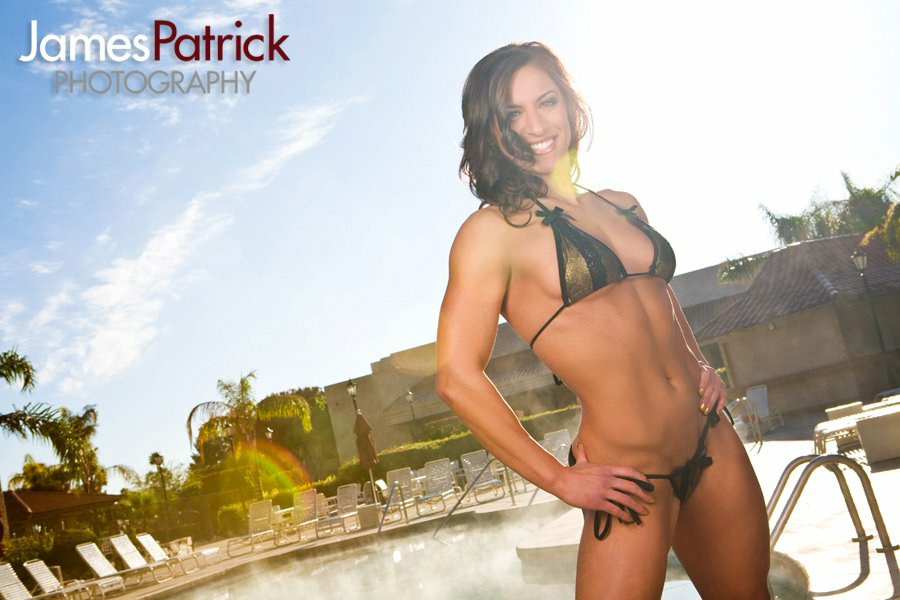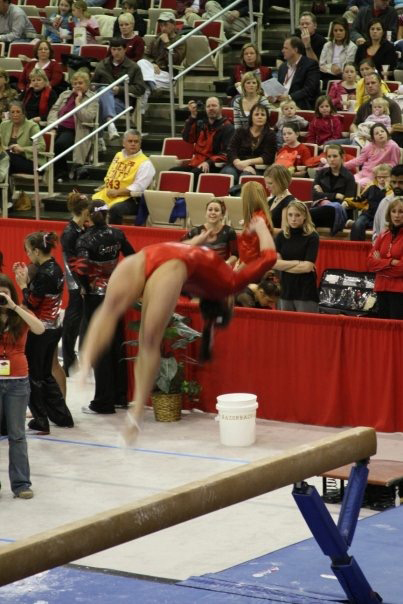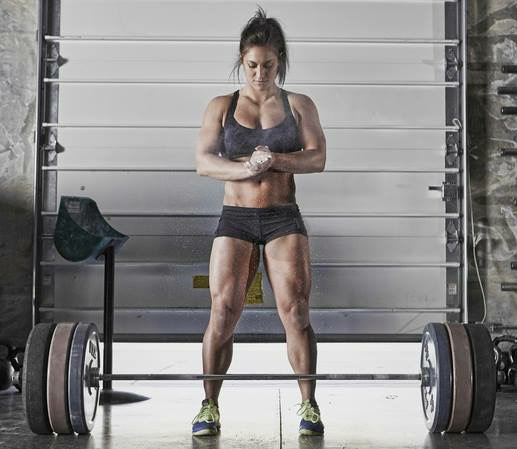It’s the oldest story in the book: a female athlete comes seemingly out of nowhere to qualify as an individual for the CrossFit Games after only having done CrossFit for a short time. Once the shock (and a little jealousy) wears off, we find out that the athlete was a high level gymnast, perhaps an NCAA All American, who started CrossFit after finishing college because suddenly she had tons of time on her hands. One year later, she’s qualified for the Games, and we all are slightly annoyed by how easy she made it look. To top it off, she’s gorgeous, has a killer body, and tons of followers on Instagram.

This is the trajectory of Alexandra LaChance…well, the part that you know about anyway. Yes, she competed at 2013 Regionals as part of a team after only doing CrossFit for four months. Yes, she entered the 2014 North Central Regionals as an individual…and won. A poorly timed stomach bug hindered her 2014 Games experience, but she still managed to finish out the weekend despite puking up everything she tried to eat.
Fast forward to today and she has more accomplishments to add to the list, including 17th place at the 2015 South Regionals (more on that in Part 2), a 190 kg total at the 2015 American Open, fitness model, and Nike athlete. Most recently, she was picked up by the NPGL’s DC Brawlers as a utility player after competing on the Phoenix Rise last year.
It seems like she has it all. Of course, having it all and feeling like you have it all are two very different things. LaChance’s success did not happen overnight, and frequently occurred in spite of illness and injury — two issues she’s still navigating. It is through these challenges that’s she’s began to come into her own not just as an athlete, but a person and a coach. We couldn’t wait to talk to her about her whirlwind life.
Brooke: You announced before the start of the Open that you would be withdrawing from the 2016 season because of a lingering injury, what’s the status as of now?
Alex: Right now I’m working on getting an MRI to see what’s going on with my back. It’s been getting better, but I hurt it over Christmas break and it’s been holding me back from pushing it too hard. I’m starting to add in a little bit of power training. I’m doing a powerlifting competition in June — sumo deadlifts feel fine on my back, and I’ve been bench pressing a lot. I just started squatting, so that gives me a goal to work toward before GRID starts in a few months.
Brooke: As a gymnast, you’ve spent your entire life working through injuries. How do work through injuries and keep coming back stronger?
Alex: I’m used to exercising while in pain…which sounds kind of weird, but that’s just what gymnastics does for you. Whether it’s muscles hurting or body parts hurting, it all feels the same to me. I can always push through it. If you can’t use your legs you find everything you can do without using that leg.
I don’t mean that I’m pushing it to re-injure it or hold it back from getting better, but as long as it doesn’t hurt worse that day and keeps progressing and getting a little bit better, it’s fine. I haven’t been Olympic lifting because that would make it worse, but with everything else I just go by feel and make adjustments.
Brooke: What have you learned about yourself while working through injuries?
Alex: One of the cool things that I’m finding out is that since I’m doing so much accessory work, I can still maintain. I haven’t been able to deadlift, but by doing all this posterior chain and glute/hamstring work without any kind of hip flexing, I’ve pretty much kept up my strength for the deadlift even though I haven’t done it in months.
Brooke: Is there any silver lining to not competing in the 2016 Games season?
Alex: I’ve had more time on my hands since I’m not training so much, and I’ve been able to grow my business. Every weekend I’m traveling across the country doing gymnastics seminars. I have a bunch of online clients that I get to coach every single day. It’s helped me become a better coach, just by having access to more athletes, which I wouldn’t have been able to do if I was doing my normal training schedule.
It still really sucks not being able to be able to compete and train, but it helps me focus my energy elsewhere so I’m not just sitting at home feeling sorry for myself.
Brooke: You seem to have a high hit rate of getting athletes to their first muscle up.
Alex: Yes! One of my programs is a gymnastics supplement, and it’s a little bit different than other gymnastics programs out there because it’s interactive. They have to videotape all of their programming, and in return I review all of their videos and coach the through video analysis.
It’s time consuming, but it’s effective. I’m very confident that they’re doing all the movements correctly and getting all the coaching they need, even though they’re in Australia or they’re on the East Coast. Even though I’m not there, I may as well be. The only thing they’re not getting is a spot from me.
Brooke: What’s the most common mistake you see in athletes going for a muscle up that they’re not getting corrected on by your average CrossFit coach?
Alex: For the people that are strong enough to do it in the first place, the biggest mistake is their grip. People hold on to the rings like a bar, like a palms face down grip, and in reality the only thing holding them back from the muscle up is keeping their wrists facing each other. It seems like a super simple correction, but over half the people that I get that’s the only thing keeping them from turning over and stabilizing themselves on top of the rings.
I think that’s something that coaches don’t always look for, because it’s not a matter of technique, it’s just grip. If your palms are face down then your wrists can’t rotate with your body as you sit up on top of the rings, so you’re always going to get spit out from the back, or if you’re super strong you can chicken wing it from there…but that’s the worst thing you can possibly do, injury wise.
Brooke: You’ve competed at the Games, the American Open, GRID, and now you’re dabbling in powerlifting. Once the back is healed, are you going to choose a particular focus?
Alex: For CrossFit, one of the cool things and one of the hard things is that it encompasses every single sport, so I don’t think you can really go wrong by trying different sports. My posterior chain is a huge weakness of mine, which is the reason why I hurt my back. I’m just really quad dominant after spending 21 years jumping off my toes [in gymnastics.] By getting into powerlifting, it’s forcing me to learn how to use my hamstrings and use my glutes, so that’s definitely going to help my CrossFit.
Olympic lifting is my favorite. I love technique and it’s my favorite thing to work on. Obviously I want to make it back to the Games, but I’d really like to do Olympic lifting competitions and powerlifting competitions throughout the season. I’m not going to be the best [at powerlifting] because I’m not putting all my focus on it, but I don’t think it can hurt to work get better at your pressing, get better at your squatting, get better at your pulling. I think it all makes you a better CrossFitter.

Brooke: What is scarier, doing beam at your first NCAA meet, or doing your first event at the CrossFit Games?
Alex: Beam is terrifying, because if you make a half of a mistake you’re off the beam and your coach is going to scream at you. Gymnastics and Crossfit are both hard, but gymnastics is so mentally tough because it’s technique based. You’re never pushing through fatigue in a gymnastics competition, it’s mostly making sure your movements are perfect.
CrossFit is terrifying because you’re pushing through extreme fatigue and you get nervous because it’s going to hurt so bad. I don’t know which one is easier on you…they’re both really hard in their own way. There’s a lot of people looking at you in CrossFit…but in gymnastics there’s thousands of people looking at you too…in a leotard…with a wedgie that you can’t pick.
Brooke: What surprised you about the CrossFit Games?
Alex: How nice everyone was. I had no idea what to expect and I was kind of there by myself, but the athletes were incredibly friendly and all the spectators were so nice. I remember running through the stadium and people were giving me high fives when I was dragging myself up and down the stairs. I thought that was so cool. In gymnastics, you don’t have that. Anyone who’s not there for you or for your team is yelling horrible things at you while you compete and then you have to try not to fall of the beam.
Brooke: Was there anything that disappointed you about the Games experience?
Alex: Personally, I was sick so I was throwing up the whole time. I couldn’t eat or drink anything after the first day. I really want to make it back and be healthy and push myself through the workouts, as opposed to trying not to pass out or throw up all over the field. That was disappointing just because I’d trained so hard to get there, and then I didn’t get to give everything I had. It was just survival.
Brooke: What’s not great about being a high level athlete?
Alex: If you want to be at that level, your whole day revolves around your training…making sure you’re eating at the right time, making sure you’re eating the right food, recovering, spending time on prehab and mobility, getting body work done. It’s a full time job and it doesn’t give you time for anything else. You can’t hang out with your friends and party till 2 in the morning. You can’t just go out to eat all the time.
I think people don’t understand, they’re like ‘oh you don’t have a job, you get to be at the gym all day. I could be that good if i got to be in the gym all day.’
There’s so much more than spending the time at the gym that people don’t understand. There’s millions of factors playing a part into it. There’s a lot of parts to it that aren’t fun. It’s not fun to go to bed early to make sure you’re getting enough sleep. It’s not necessarily fun to get body work done when your soft tissue guys make your legs feel like they’re going to explode. But, it’s all necessary because the sport is so physically and mentally demanding. It’s not just showing up to the gym for 6 hours. It might have started that way, but it’s evolved so much and everybody’s so good now, that every tiny little detail matters.
Brooke: Is it even realistic for new athletes to be aiming for the Games?
Alex: I think so. I think anybody can be good at it, but not everybody will be good at it. You can be new and do really well, but it helps to have an athletic background and an understanding of the training that goes into it. I think those cases are going to be a lot more rare. Olympic lifting technique is so fine tuned now that if you’re a girl you’re not just going to walk into a gym if you haven’t been lifting and pull 200 pound snatch, or be able to rep out 10 or 15 muscle ups in a row. It’s not enough to be able to a couple muscle ups, now you have to have a lot of muscle ups. You have to have a great engine too…and the chance of people walking into the sport with that foundation is more slim than before.
In Part 2 of our interview with Alex, she opens up about illness, body image, and dealing with it all under the watchful eye of nearly 70,000 Instagram followers.
